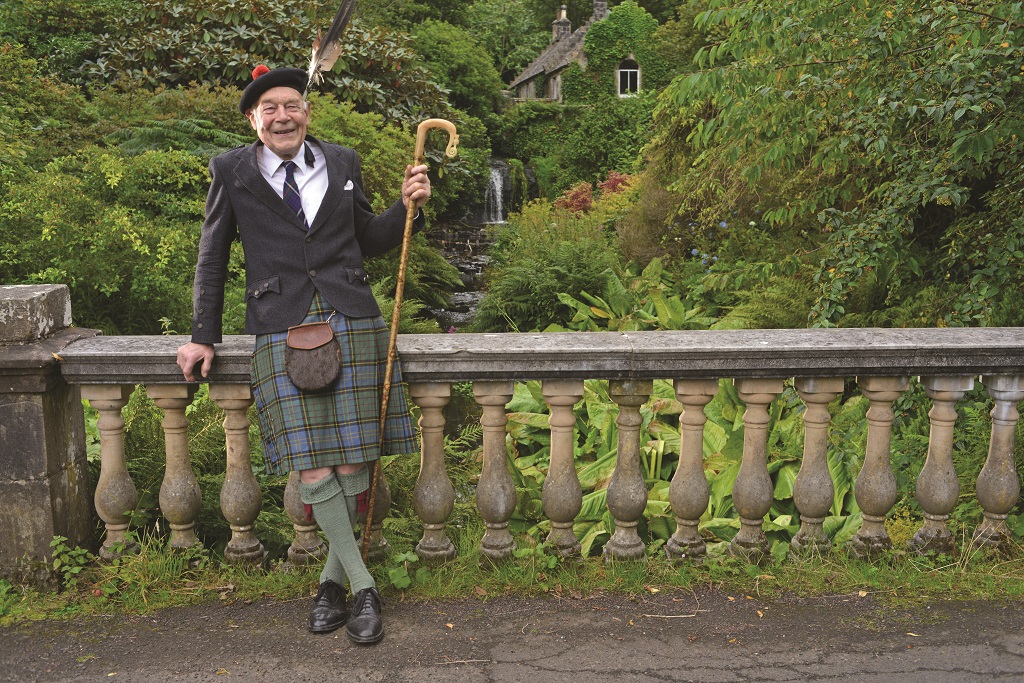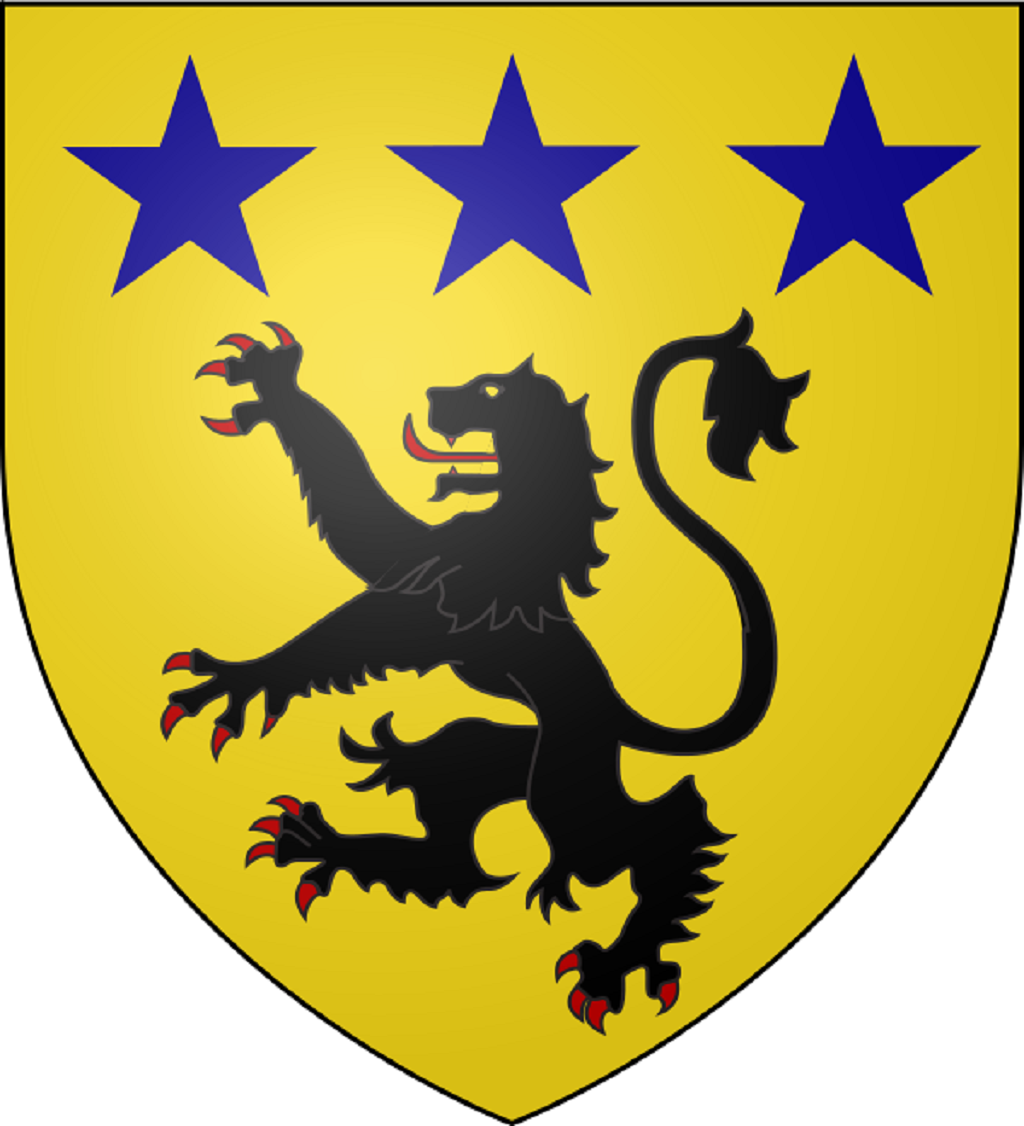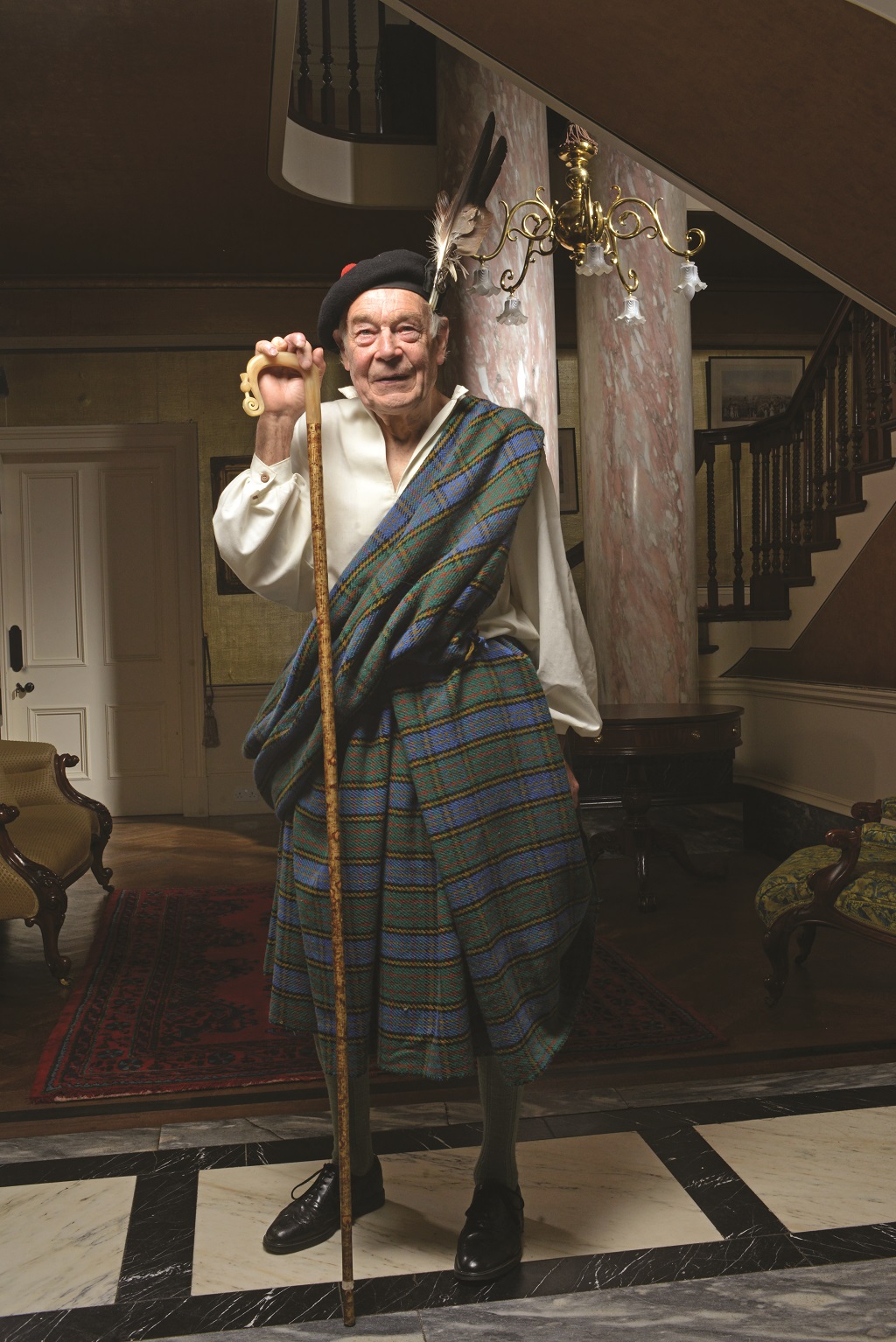
Macmillan clan chief keeps the wheels turning
In the impressive grounds of Finlaystone House, Port Glasgow, stands an ancient Yew tree, known as the John Knox Tree.
The tree, which survived a shell exploding on the lawn during the Second World War, provided the canopy under which Knox gave his first communion in the west of Scotland in 1556.
Today, George MacMillan, Chief of Clan MacMillan, can often be found beneath its branches, tending the beautiful woods and gardens at Finlaystone House and Estate, seat of the MacMillan Clan, which welcomes many members each year.
At over 800 years old, Clan MacMillan is one of the oldest, most active clans in Scotland. The MacMillans are descended from a 12th century monk or lay priest called Gilchrist; a son of Cormac, Bishop of Dunkeld, whose great great grandfather was the Scots king Macbeth. The collective name of his descendants, the Clann an Mhaoil or ‘children of the ‘Macbeth’s great-great grandson was an interesting figure by the name of Cormack, who started life as Abbot of Dunkeld in the Celtic Church, and was persuaded by one of the more enlightened Scottish kings to come over to the Roman Church and become Bishop of Dunkeld,’ explains George.
‘Until then, the leading houses who contended for the throne of Scotland were Macbeth and Canmore. When Macbeth’s lot had disappeared to Northern Ireland, part of their back base, Cormack suddenly appeared as this rather high-powered Celtic cleric, and the two power rubes were really united after that, so it was a very strategic moment.’
Dunkeld’s location at the foot of the Highlands provided access to the whole north of Scotland, a fact George attributes to the scattering of MacMillans throughout the country. ‘If you go to Dunkeld, there’s a list of the bishops, including Cormack in 1127. He had lots of sons and most of them founded clans.

George MacMillan in his full clan chief regalia (Photo: Angus Blackburn)
‘Ours was called Gilchrist, meaning servant of Christ. But he was a bit bolshie according to reports and the theory is that he disapproved of his father ‘selling them down the river’, by going to Rome. So he shaved his head in the Celtic fashion – shaving everything forward of the ears – rather than the Roman fashion.
‘He then withdrew to the north west and little colonies of MacMillans sprang up in various places, mainly up and down the coast because they all travelled by boat. This was around the end of the 12th century and roads didn’t really exist, so that’s how they ended up in Galloway and Argyll. Some settled around Ben Lawers as well, some around Loch Arkaig just north of Achnacarry, and then there was a little posse around Castle Sween. They were all tenants and they were stubborn.
‘The Ben Lawers ones were moved forcibly because they were such a nuisance. They had this terrible battle in 1396 in Perth, the Battle of the Clans, a 30-a-side pitched battle with an audience watching. I think there were nine survivors and the MacMillans were almost certainly on the losing side. We play the victim really, but I suspect it was because they were such pests.’
Centuries on from the clan wars, MacMillans have evolved into pioneering, empathetic and talented people, with Dumfriesshire-born blacksmith and bicycle inventor Kirkpatrick Macmillan (1812-1878); Macmillan Cancer Support founder Douglas MacMillan (1884-1969); and former Prime Minister Harold MacMillan (1894-1986) among the notable members of recent times. MacMillans are also prevalent in the arts.
‘There’s Sir Ernest MacMillan, who was conductor of the Toronto Symphony and was active in forming the North American Society; then there was Sir Kenneth, the ballet man; and now we’ve got our very own Sir James MacMillan who has just been knighted for his musical work,’ George says. ‘It’s all rather surprising because we, as a family, are anything but artistic.’
Sporting talent, however, does run through George’s family, with his younger brother John representing Great Britain in the 1952 Helsinki Olympics. ‘He and his friend (Peter Brandt) decided to go in for the trials for the double sculls after winning the bumps races in Cambridge. The trials were a fortnight later, so they started from a pretty low base of training. John and Peter were actually beaten by the people who had won the Olympics in ’36, but the judges felt they might have won if the other people hadn’t got in their water, so they said they’d have a retrial. They trained hard for it and easily beat the old boys. So John and Peter went to Helsinki. I’m afraid they didn’t do terribly well – they were knocked out in the first round – but they had a great time.
‘It’s changed since then, of course. I’ve got a grandson who is very keen on rowing and it’s absolutely full time. He does his exercises with a row of dials in front of him to tell him what his heart rate is, John would never have bothered with all that!’

The MacMillan of MacMillan and Knap Arms
George inherited the chiefdom from his father, General Sir Gordon H. A. MacMillan, who was declared by the Lord Lyon to be the Hereditary Chief of Clan MacMillan in 1952 (he was found to be the heir of his great-greatgrand uncle Duncan MacMillan of Dunmore, who had died childless 153 years before).
The discovery of a chief stimulated a renewal of interest in their clan roots by MacMillans all over the world and George represented his father on a number of occasions at overseas gatherings of the clan, before himself succeeding as MacMillan of MacMillan following Sir Gordon’s death in 1986.
‘I knew it would come to me, which was a daunting prospect, but it actually worked out quite well as I married the best person I could possibly imagine,’ says George of his late wife, Jane.
During the 1980s, Jane developed Finlaystone as a visitor attraction. ‘Although Jane wasn’t used to running something like this, she got the hang of it reasonably quickly. I really couldn’t have been luckier,’ says George.
The chief’s late wife was also instrumental in setting up the MacMillan Clan Centre in a stable block at Finlaystone, where members can view the archives.
Last year George hosted a gathering of the MacMillans in Scotland, with members travelling from Australia, New Zealand, America, Canada and Norway. ‘We try to run things like this every few years and I try to attend the gatherings abroad,’ he says. ‘I usually get to the North American Society’s, which was really designed to straddle the border between Canada and the USA, and they alternate their gatherings, so one time it’s in Canada, the next in the States.’
Despite enjoying the hosting, gatherings, travelling and other activities that, at 85 years old, still fill his life, George’s first love, along with his immediate family, is Finlaystone. Although he was born in London, George spent lots of time at the house as a boy. ‘My mother’s mother lived here at that point,’ he says. ‘My pa was in the army and whenever we moved house, which we did quite often, my mother and I were sent up here while the move was on. I was probably about two years old when I first came here so I’ve always known it. I came back permanently in 1974, so I’ve lived here for almost half my life.’
The house, originally built in the 13th century, has been in George’s family since the late 1800s, when George Jardine Kidston – George’s grandfather on his mother, Marion Blackiston-Houston’s, side, who had made his money as chairman of the Clyde Shipping Company – bought Finlaystone after renting it for 25 years. After purchasing the house outright, Kidston engaged John James Burnet, a leading architect who studied at the Institute des Beaux Arts in Paris, to give the house some style and fit it better for his family.

The ground floor, enlarged to accommodate a porch, cloakroom and a billiard room, was developed mainly with men and sport in mind, while a top storey was built in the roof to provide nurseries for grandchildren and a flat for the butler. Burnet added a cornice and carved stone crest at the roof line and a pair of pink marble pillars to the stair rail ending, complete with the architect’s signature, a mythological beastie, at their base.
Having read Classics at Trinity College, Cambridge, George initially pursued an academic career. After teaching classics at Wellington College, Berkshire, for ten years, he was invited to Trinity College, Toronto in 1963 where he spent a year as Visiting Professor in Religious Studies. It was during this time that George and Jane made the acquaintance of many of the Canadian MacMillans.
Upon their return to Britain, George took up a post as lecturer in religious studies at Bede College, Durham, within easy reach of the Finlaystone Estate, which George had inherited in 1955 from his maternal grandmother, and where his father settled after retiring from the army. George and Jane left Durham in 1974 to join Sir Gordon and Lady Marion in running Finlaystone.
‘We overlapped with my parents for quite a long time – they lived in the house as they had done and we lived in the roof. There used to be this extraordinary set up where my father would sit at one end of the dining room table and my mother would be at the other side, and then between the two of them, strung out around the table, were all these young people who were helping around the estate. My mother was pretty deaf and my father would open
the mail and say, “We got a letter from so and so,” and my mother would say, “WHAT?” This would go on in full view of everybody.’
The gardens had been Lady Marion’s passion – she had the herbaceous border added in 1939 – and she looked after them until Jane took over. ‘My mother was an obsessive gardener and she ran it very well,’ George recalls. ‘She did an enormous amount of work and my sister Judy was a willing accomplice. In the early days, when she was just leaving school, a few of her friends were drawn into it too. They used to help keep the garden going. My
mother always said, “I would never ask anyone to do something I wouldn’t do myself,” but as she would do anything, she didn’t really need much help, so she’d make them skin rabbits and everything else. She wasn’t dictatorial, she just assumed people would do things. She was very straightforward, you knew exactly where you were with her.’
Finlaystone House and Estate remains one of Renfrewshire’s most popular paid visitor attractions. The house today is owned by George and Jane’s eldest son, Arthur, who lives at Finlaystone with his wife Barbara and their two sons.
This feature was originally published in 2016.
TAGS

